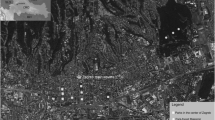Abstract
To facilitate field surveys for identifying areas of incineration residue-derived soil contamination, a simple and convenient method with a soil electrical conductivity meter was examined. First, the leaching test specified by Notification No. 13 of the Ministry of the Environment, 1973, was conducted on 506 samples of 11 types of wastes and compost, and the relationship between the concentrations of toxic elements [total Hg (T-Hg), Cd, Pb, Cr6+, and As] and values of electrical conductivity (EC) was examined. The results showed that bottom ash and fly ash were wastes with high EC values and that these wastes indicated higher levels of toxic elements. Second, an estimation method for the soil EC value of contaminated soil (ECc) was proposed based on the EC values of noncontaminated soil, and its usefulness was examined. The results of field surveys conducted at sites whose soils were suspected of contamination by dioxins and other pollutants derived from incineration residues showed that the contaminated spots and areas were identified by using ECc values. Moreover, comparison of the elemental contents of soils in terms of Cr, Ni, Zn, Na, K, Ca, Fe, Mn, and others, in addition to the above-mentioned toxic elements (excluding Cr6+), with those of the potential sources of pollution was verified to be effective for identifying the source of soil contamination.
Similar content being viewed by others
References
Environmental Management Bureau, Environment Agency, Japan (2005) Outline of survey results on soil pollution survey, countermeasuring examples and responsive states, in 2003 FY. (in Japanese) Ministry of the Environment, Tokyo, Japan
JN Shaw PL Mask (2003) ArticleTitleCrop residue effects on electrical conductivity of Tennessee valley soils Commun Soil Sci Plant Anal 34 IssueID5–6 747–763 Occurrence Handle10.1081/CSS-120018973 Occurrence Handle1:CAS:528:DC%2BD3sXjtlyis78%3D
InstitutionalAuthorNameMinistry of the Environment, Japan (2002) Soil Pollution Countermeasures Law Ministry of the Environment Tokyo, Japan
U.S. EPA (1996) Test methods for the evaluation of solid waste, physical/chemical methods. http://www.epa.gov/SW-846/pdfs/3050b.pdf
Author information
Authors and Affiliations
Corresponding author
Rights and permissions
About this article
Cite this article
Nagamori, M., Watanabe, Y., Hase, T. et al. A simple and convenient empirical survey method with a soil electrical conductivity meter for incineration residue-derived soil contamination. J Mater Cycles Waste Manag 9, 90–98 (2007). https://doi.org/10.1007/s10163-006-0163-8
Received:
Accepted:
Published:
Issue Date:
DOI: https://doi.org/10.1007/s10163-006-0163-8




